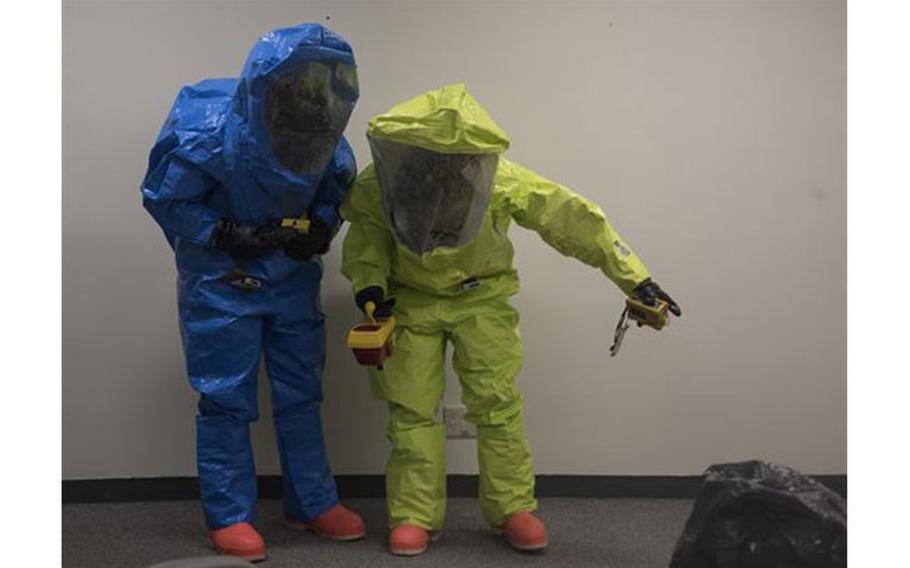Community News
Pacific Air Forces tests 35th Medical Group readiness
Stripes Japan October 10, 2017

()
MISAWA AIR BASE, Japan -- The 35th Medical Group held a counter-chemical, biological, radiological and nuclear attack invitational exercise, to test and execute readiness capabilities while being evaluated by Pacific Air Forces’ medical inspector, Sept. 28.
Should a CBRN attack transpire, a multitude of victims would potentially be affected by the crisis. The 35th MDG would immediately care for critical patients, ensuring to be the first to respond to casualties or injuries.
“The purpose of the exercise is to build up all our capabilities,” said 1st Lt. Matthew Wilson, a 35th Medical Support Squadron readiness officer. “Inside the medical group, we have Airmen assigned to medical contingency response teams, who feed directly into different plans and programs our wing is tasked to support.”
All squadrons within the group flexed their knowledge and skills, bringing quality care to simulated patients and carrying out rapid response to various scenarios thrown their way.
“Our responsibility is responding to support the Indo-Asia-Pacific region, whether it’s our brothers and sisters across the lake in the Republic of South Korea or another base in the Pacific,” Wilson said.
The exercise included an in-depth evaluation from John Lacio, the PACAF medical counter CBRN program manager, who visits every two to three years and spent three days refining the teams’ actions by providing quality feedback to service members.
“My purpose for visiting Misawa Air Base was to ensure readiness from a medical perspective,” Lacio said. “Once the evaluation was complete, I reported the statistics directly to the 35th MDG commander.”
The inspector evaluated the medical counterresponse teams, validating they were well-prepared to respond to any possible situation that could happen in their area of operation, which covers approximately 60 percent of the globe.
“The medical counter CBRN teams can respond to various incidents from A to Z,” Lacio affirmed.
Some of the scenarios included responding to explosives containing a biological attack agent, causing many injured and casualties, while medical personnel treated the simulated patients.
Although the exercise primarily focused on medical teams, other units who work hand-in-hand with first responders tested their synergy to see how well they worked with Team Misawa’s MDG. Units from the 35th Security Forces Squadron and 35th Civil Engineer Squadron bioenvironmental shop investigated the scene while testing for contaminated air.
“We invite other teams, like the fire department and security forces, who often connect with medical during incidents,” Lacio stated. “My expectations were for people to be trained and have equipment ready, taking both of those pieces and executing their job with precision when called to do so.”
Wilson described the medical field in the Air Force as a unique subculture within the military and said where most units will have 50 or so Airmen per officer, a medical group could only have one or two Airmen for every officer.
Normally, officers only stay for a few years, leaving little time for overlap between incoming doctors.
“It’s very important for experienced personnel to be present at all times,” Wilson said. “Those considered to be subject matter experts often stay here for only two years, so with the constant change of personnel coming in and leaving, we have to be able to get them spun up quickly on operations.”
Lacio explained medical personnel rarely participate during in-depth exercises due to their responsibilities handling real-world scenarios.
“This exercise prepares all of our personnel because during a contingency this base becomes a medical hub,” Wilson said.
With exercises, the 35th MDG ensures their Airmen obtain training needed by building up their capabilities across their teams, whether they are new to the operational Air Force or have experience in the medical field. They can continuously support the mission, allowing Team Misawa to fly, fight and win in air, space and cyberspace.
Photo Caption:
U.S. Air Force Airman 1st Class Erickson Dixon, right, and Senior Airman Petri Brand, left, both 35th Aerospace Medical Squadron bioenvironmental engineer technicians, detect chemical substances during a medical readiness exercise at Misawa Air Base, Japan, Sept. 28, 2017. Pacific Air Forces headquarters’ medical counter chemical, biological, radiological and nuclear program manager evaluated all teams participating in the exercise and provided in-depth feedback in order to further build upon their capabilities to meet the readiness standards in the Indo-Asia-Pacific region.